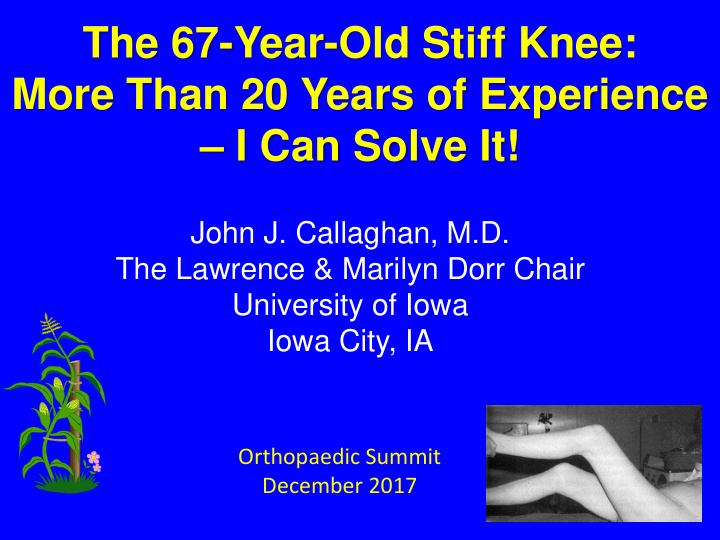



The 67-Year-Old Stiff Knee: More Than 20 Years of Experience – I Can Solve It! John J. Callaghan, M.D. The Lawrence & Marilyn Dorr Chair University of Iowa Iowa City, IA Orthopaedic Summit December 2017
Disclosures • Consultant and Royalties (DePuy) for intellectual property transfer for hip & knee implant designs. • Royalties (Wolters Kluwer) for books edited. • Board Membership – Journal of Arthroplasty – International Hip Society – OREF (Orthopaedic Research and Education Foundation) – Knee Society
67 Year Old Man with Stiff Knee status post TKA (3 years ago) Severe pain active ROM 30-80 degrees
Prevention Better Than Treatment Pre-Operative Considerations: • Proper indications: – Not just “arthroscopic arthritis” – Poor preoperative motion – Realistic expectations
Prevention Better Than Treatment Intra-Operative Considerations: • Appropriate soft tissue releases and osteophyte resection • Avoidances: – Over stuffing the patella femoral joint – Over stuffing the flexion or extension gap, or both
Prevention Better Than Treatment Post-Operative Considerations: • Aggressive pain reduction protocols – Oxycontin – Anti-inflammatory Pre-op – Tylenol • Injections intra op • Post op blocks – Splints for extension – Anti-depressants • Manipulate if necessary
Treatment for Stiff TKA • Manipulation: – 2-4 months post op • Arthroscopic debridement: – limited indications in the first year or 2 post op • Revision of components
Treatment for Stiff TKA: Manipulation (2-4 months) • Recommend performing by 3 months post op • Rates vary from 1.8% to 6% – Probably related to indications for manipulation • Improvement in motion ranges from 22-40 degrees • Young age and females higher rates • Obesity protective
Treatment for Stiff TKA: Arthroscopic Debridement • PCL release (Windsor et al, CORR 1996) – Pre op motion: 4-70 degrees – Post op motion: 1.3-112 degrees – Most successful if patient comes to full extension pre-operatively • Global debridement (Windsor et al, JOA 1996) – Results: 42% good, 19% fair, 40% poor
Treatment for Stiff TKA: Revision of Components Patient work up history, looking for supratentorial issues • Multiple arthroscopies prior to TKR • Pre-operative radiographs with minimal if any arthritis • Workman’s compensation • Psychological issues – (“How high a squirrel count”) – Dorr (JOA 1990). Poor results • Patella baja • Keloid formation • More than 4 surgeries • PS TKA
Exclude or Identify Extrinsic Sources of Knee Stiffness • Causes – Severe OA of ipsilateral hip – Muscle rigidity (from neurologic injury) – Tight quadriceps/hamstrings from injury – Heterotopic Ossification • Revision TKA unlikely to have favorable outcome without correction of Extrinsic Problem
Intrinsic Causes of Knee Stiffness Following TKA • Overstuffing of the patellofemoral articulation • Excessively tight flexion and/or extension gap • Tight posterior cruciate ligament • Femoral and/or tibial malrotation • Arthrofibrosis • Infection
Overstuffing of the Patellofemoral Articulation • Anterior displacement of anterior flange of the femoral component – Due to oversizing of the femoral component – From anterior translation of an appropriately sized femoral component • After patellar resurfacing if patellar component composite thickness is increased
Excessively Tight Flexion and/or Extension Gap • Decreased Flexion (tight flexion gap) – Amount of posterior femoral condylar bone resected is less than thickness of the posterior condyles of the femoral component (increasing offset) – Femoral component oversized or placed posteriorly – Tibial component placed in neutral or anterior slope • Decreased Extension (tight extension gap) – Distal femoral resection is too distal – Tibial insert is too thick – Inadequate tibial resection (tightens flexion and extension gap)
Malrotation • Femoral and/or Tibial Malalignment or Malrotation may lead to pathologic tightness of soft tissue structures • Malalignment – Asymmetry of the extension gap • Malrotation – Asymmetry of the flexion gap – Patellar tracking problems
Arthrofibrosis • Excessive pathologic postoperative scarring inhibiting flexion and/or extension • One of most unresponsive causes of stiffness
Evaluation • Is patella too thick? • Was adequate bone removed? • Is femoral component too large? • Was tibial insert too thick? • Are components well aligned? – Appropriate femoral components sizing, offset restored? – Rotation correct? – Tibial and femoral resection appropriate? – Is tibial component slope correct?
• CR knee • No posterior tibial slope • Stuffed patellofemoral joint • Limited distal femoral resection 30-80 degrees flexion preop
Patella • Prefer patellar subluxation over eversion – Less risk of patellar avulsion • If patella cannot be mobilized laterally – Lateral retinacular release – Quadriceps snip
Surgery • Thin patella • Undersize femoral component • Elevate joint line if necessary • Use TC3 if loose flexion gap • Substitute PCL
5-110 degrees flexion post op
30-70 degrees flexion
0-120 degrees flexion
Post Op • Aggressive pain reduction protocols – Oxycontin – Anti-inflammatory Pre-op – Tylenol • Injections intra op • Post op blocks – Splints for extension – Anti-depressants • Manipulate if necessary
Haidukewych et al Dorr et al Christensen et al Lotke et al • 1.3% of TKRs • KSS 38 86 • KSS function 40 58 pts • KSS pain 15 47 pts • Mean motion 54 82° • Flexion 66 85° • Extension 11 3°
• 42 knees • 47 month avg f/u • Flexion contracture 9.7 2.3 • Flexion 81 94 • ROM 72 92 • KS Functional Score 48 70 • Pain improved 73%
Stiff TKR: Discussion • Avoidance better than treatment • Realistic expectations (motivated patients do best) • Revise only if you see something you can fix
Thank You
Recommend
More recommend